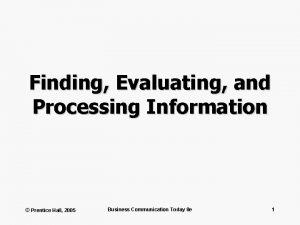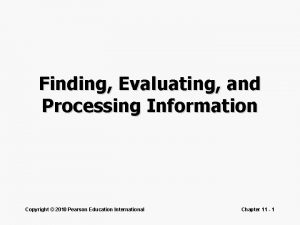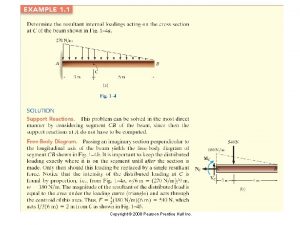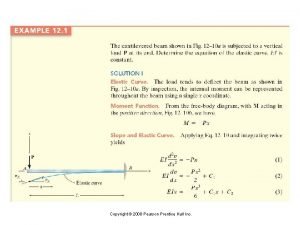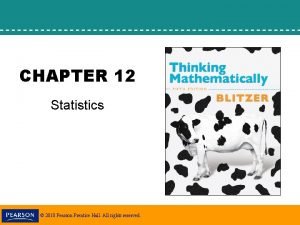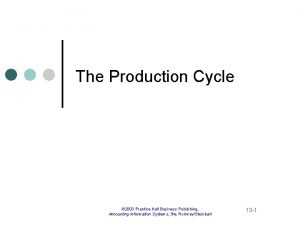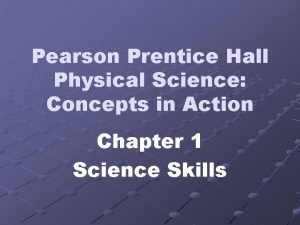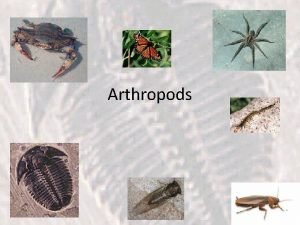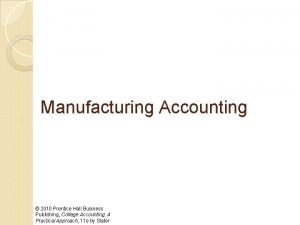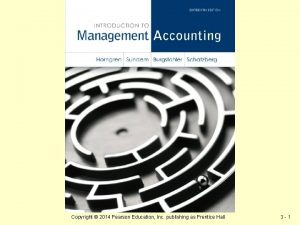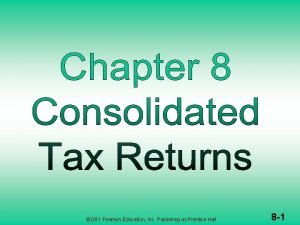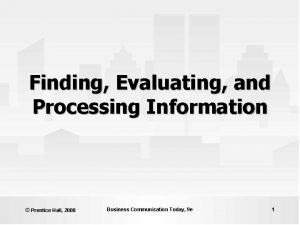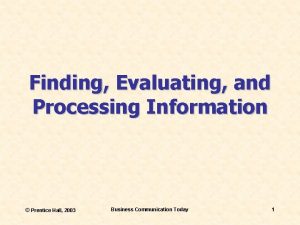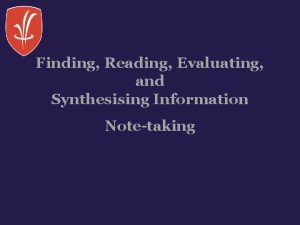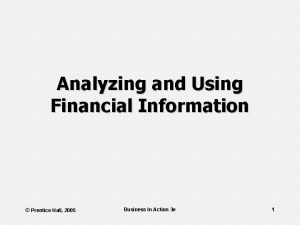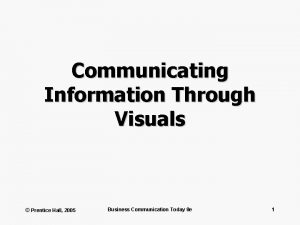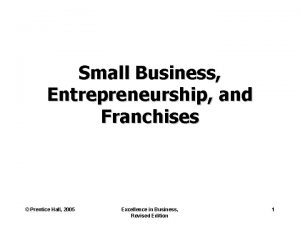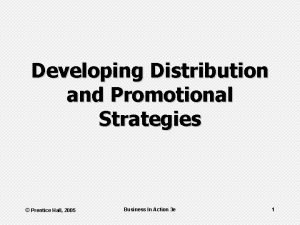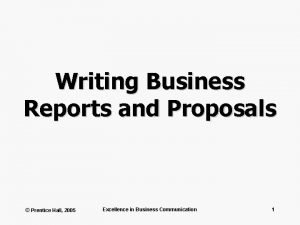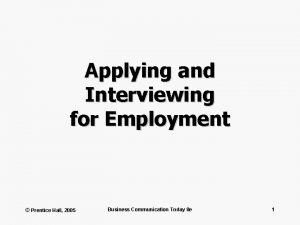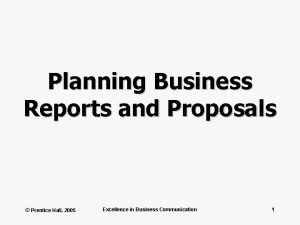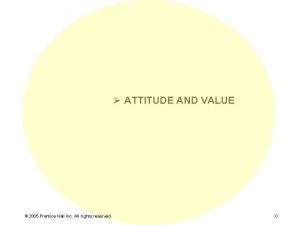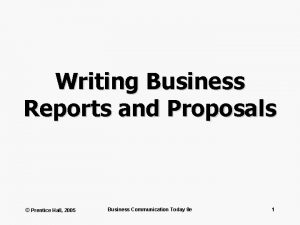Finding Evaluating and Processing Information Prentice Hall 2005

























- Slides: 25

Finding, Evaluating, and Processing Information © Prentice Hall, 2005 Business Communication Today 8 e 1

The Research Process • • • Plan your research Locate data and information Process data and information Apply your findings Manage information © Prentice Hall, 2005 Business Communication Today 8 e 2

Plan Your Research • Learn about the subject • Identify information gaps • Prioritize research needs © Prentice Hall, 2005 Business Communication Today 8 e 3

Ethics and Etiquette in Business Research • • • Don’t skew results Respect privacy of participants Document sources Respect intellectual property Don’t misquote © Prentice Hall, 2005 Business Communication Today 8 e 4

Learn About the Subject • Industry publications • Competitor’s websites • Interviews with Experts © Prentice Hall, 2005 Business Communication Today 8 e 5

Information Gap Analysis 1. 2. 3. 4. 5. Clarify the decision or conclusion Identify subquestions Clarify information requirements Locate existing information Assess the information gap © Prentice Hall, 2005 Business Communication Today 8 e 6

Data and Information • Secondary research • Primary research © Prentice Hall, 2005 Business Communication Today 8 e 7

Evaluating Sources Honesty and Reliability Potential Bias Purpose of the Material The Author Data Collection Methods Independent Verification Completeness Logic and Good Sense Timeliness © Prentice Hall, 2005 Business Communication Today 8 e 8

Secondary Research • A specific company • An entire industry • Statistics and trends • Business issues © Prentice Hall, 2005 Business Communication Today 8 e 9

Finding Information at the Library Business Books Directories © Prentice Hall, 2005 Electronic Databases Newspapers Periodicals Almanacs Statistical Resources Government Publications Business Communication Today 8 e 10

Online Information • Internet public library • Company websites © Prentice Hall, 2005 Business Communication Today 8 e 11

Internet Search Tools • Search engines – Web directories – Online databases – Meta-search engines © Prentice Hall, 2005 Business Communication Today 8 e 12

Search Techniques • Keywords • Boolean operators • Natural language • Forms-based © Prentice Hall, 2005 Business Communication Today 8 e 13

Fine Tune Search Methods • Read instructions • Review your options • Adjust search scope • Understand details • Vary search terms • Employ search agents © Prentice Hall, 2005 Business Communication Today 8 e 14

Documenting Sources • Credit sources • Build credibility • Help your readers © Prentice Hall, 2005 Business Communication Today 8 e 15

Primary Information • Surveys • Interviews • Experiments • observations © Prentice Hall, 2005 Business Communication Today 8 e 16

Survey Questions • Ask easy-to-analyze questions • Avoid leading questions • Ask one question at a time • Pretest all questionnaires © Prentice Hall, 2005 Business Communication Today 8 e 17

Effective Interviews • Purpose – Collect information – Make decisions – Clarify issues • Structure – Overall length – Stylistic issues – Organization © Prentice Hall, 2005 Business Communication Today 8 e 18

Types of Questions • Close-ended • Restatement • Direct open-ended • Open-ended © Prentice Hall, 2005 Business Communication Today 8 e 19

Preparing Questions • Think about sequence • Rate the questions • Ask smart questions • Mix types of questions • Limit the number • Edit questions © Prentice Hall, 2005 Business Communication Today 8 e 20

Processing Interview Information • Quoting • Paraphrasing • Summarizing © Prentice Hall, 2005 Business Communication Today 8 e 21

Analyzing the Data • Mean, median, and mode • Overall trends • Cause and correlation • Cross-tabulation © Prentice Hall, 2005 Business Communication Today 8 e 22

Minimize Mistakes and Misinterpretations • Avoid faulty comparisons • Don’t push research results • Avoid misleading presentations © Prentice Hall, 2005 Business Communication Today 8 e 23

Applying Your Findings • Unbiased summary • Logical conclusion • Feasible recommendations © Prentice Hall, 2005 Business Communication Today 8 e 24

Knowledge Management • Information • Insights • Experiences • Research © Prentice Hall, 2005 Business Communication Today 8 e 25
 Finding evaluating and processing information
Finding evaluating and processing information Finding evaluating and processing information
Finding evaluating and processing information Copyright 2005 pearson prentice hall inc
Copyright 2005 pearson prentice hall inc 2005 pearson prentice hall inc
2005 pearson prentice hall inc Copyright 2008
Copyright 2008 Prentice hall inc
Prentice hall inc 2008 pearson prentice hall inc
2008 pearson prentice hall inc Pearson prentice hall
Pearson prentice hall Prentice hall inc
Prentice hall inc Prentice hall careers
Prentice hall careers Prentice hall america pathways to the present
Prentice hall america pathways to the present 2011 pearson education
2011 pearson education Prentice hall publishing
Prentice hall publishing Prentice hall african american history
Prentice hall african american history Prentice hall physical science: concepts in action
Prentice hall physical science: concepts in action 2011 pearson education inc
2011 pearson education inc Pearson prentice hall
Pearson prentice hall Pearson prentice hall
Pearson prentice hall Pearson education inc publishing as pearson prentice hall
Pearson education inc publishing as pearson prentice hall Pearson prentice hall
Pearson prentice hall Prentice hall business publishing
Prentice hall business publishing Pearson education inc. publishing as prentice hall
Pearson education inc. publishing as prentice hall Pearson education inc. 2012
Pearson education inc. 2012 Pearson education inc publishing as pearson prentice hall
Pearson education inc publishing as pearson prentice hall Prentice hall jobs
Prentice hall jobs Pearson education inc. publishing as prentice hall
Pearson education inc. publishing as prentice hall
